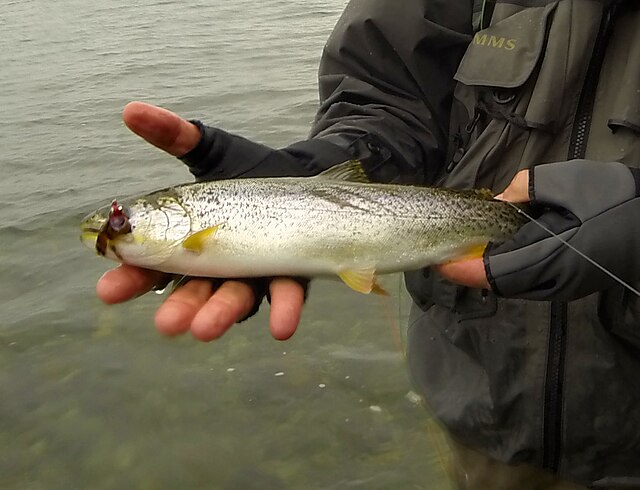The coastal cutthroat trout, also known as the sea-run cutthroat trout, blue-back trout or harvest trout, is one of the several subspecies of cutthroat trout found in Western North America. The coastal cutthroat trout occurs in four distinct forms. A semi-anadromous or sea-run form is the most well known. Freshwater forms occur in both large and small rivers and streams and lake environments. The native range of the coastal cutthroat trout extends south from the southern coastline of the Kenai Peninsula in Alaska to the Eel River in Northern California. Coastal cutthroat trout are resident in tributary streams and rivers of the Pacific basin and are rarely found more than 100 miles (160 km) from the ocean.
Coastal cutthroat trout
Typical northwest saltwater estuary environment for cutthroat trout, Quillayute River, Washington
The Nehalem River at Vernonia, Oregon
Typical sea-run cutthroat habitat, Puget Sound beach
The cutthroat trout (Oncorhynchus clarkii) is a fish species of the family Salmonidae native to cold-water tributaries of the Pacific Ocean, Rocky Mountains, and Great Basin in North America. As a member of the genus Oncorhynchus, it is one of the Pacific trout, a group that includes the widely distributed rainbow trout. Cutthroat trout are popular gamefish, especially among anglers who enjoy fly fishing. The common name "cutthroat" refers to the distinctive red coloration on the underside of the lower jaw. The specific name clarkii was given to honor explorer William Clark, coleader of the Lewis and Clark Expedition.
Cutthroat trout
Head of Yellowstone cutthroat trout (O. c. bouvierii), showing the characteristic red bands under the gill covers and mandibles
Typical cutthroat trout habitat in the East Fork of the Bitterroot River, Sula, Montana
Stocking cutthroat trout at Pyramid Lake in Nevada in 1973








